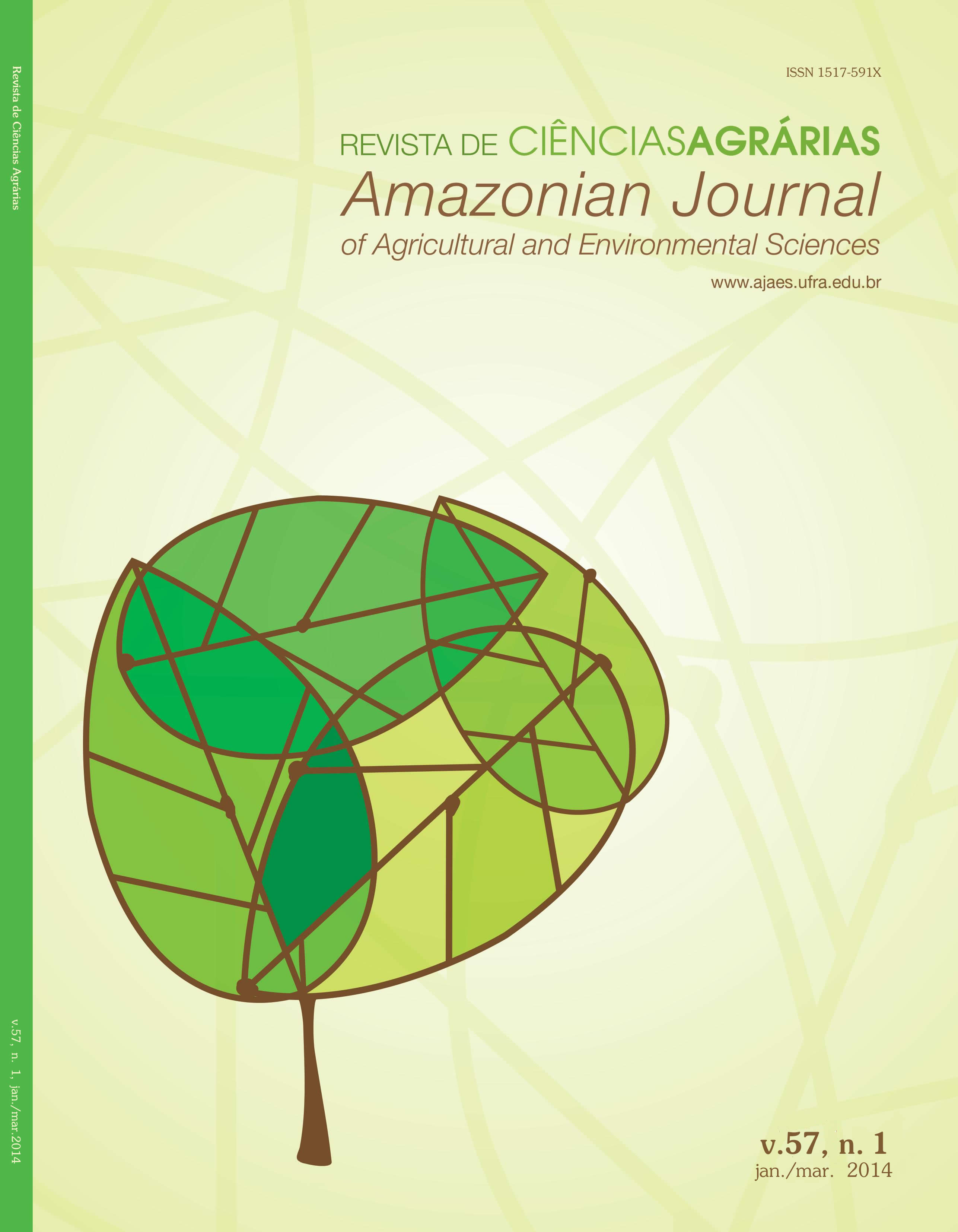Mycelia growth and sporulation of Fusarium chlamydosporum species complex under different culture conditions
Abstract
The Fusarium genus exhibits morphological, physiological and genetic variation among its different species, which may lead to differences in the environmental conditions required for their cultivation. This study aimed to verify the effects of different culture media and lighting regimes on the mycelial growth and sporulation of Fusarium chlamydosporum species complex isolates that are pathogenic to Carya illinoinensis. Four isolates from infected Carya illinoinensis roots and inflorescences were selected; these isolates were purified and subsequently transferred to four different culture media: potato sucrose agar (PSA), water agar (WA), potato dextrose agar (PDA) and carnation leaf agar (CLA). The isolates were then submitted to three different lighting regimes: a photoperiod of 12 h (TL), continuous light (CL) and continuous darkness (CD). After seven days of incubation under the three lighting regimes, the mycelial growth was evaluated on PSA, WA and PDA, and sporulation was evaluated on PSA, WA, PDA and CLA. In general, PSA and BDA media support mycelial growth and sporulation, particularly under CL. CLA medium also supports sporulation, particularly under CL. The CD lighting regime and the WA medium are not recommended for either the mycelial growth or sporulation of the F. chlamydosporum species complex.Downloads
References
ALFENAS, A.C.; FERREIRA, F.A.; MAFIA, R.G.; GONÇALVES, R.C. Isolamento de fungos fitopatogênicos. In :ALFENAS, A.C.; MAFIA, R.G. (Eds.). Métodos em fitopatologia. Editora: UFV, Viçosa, 2007. p. 53-91.
BIZZETTO, A.; HOMECHIN, M.; SILVA, H. P. Diplodia maydis e Gibberella zeae: produção micelial e esporulação em substratos naturais e meios de cultura. Summa Phytopathologica, Campinas, v. 26, n. 1, p. 88-91, 2000.
BRAGULAT, M.R.; MARTÍNEZ, E.; CASTELLÁ, G.; CABAN, F.J. Selective Efficacy of culture media recommended for isolation and enumeration of Fusarium spp. Journal of Food Protection, v. 67, n. 1, p.207-211, 2004. http://www.ncbi.nlm.nih.gov/pubmed/14717377
BURGESS, L. W.; SUMMERELL, B. A.; BACKHOUSE, D. Biodiversity and population studies on Fusarium. In: LOGRIECO, A.; SEIFERT, K. A.; LESLIE, J. F. A. et al. Biodiversity of toxigenic Fusarium species. Sydowia, Horn, v. 30, p. 1-11. 1997.
BURGESS, S. W., SUMMARELL, E. A., BULLOCK, Z., GOTT, T. P. E BACKHOUSE, V. Laboratory Manual for Fusarium Research. 3rd ed. Sydney University of Sydney and Royal Botanic Gardens. 1994.
COSTAMILAN, L. M. Recuperação de colônias de Fusarium solani f.sp. glycines de solo e de restos culturais. Passo Fundo: Embrapa Trigo, 2003. 16 p. http://www.cnpt.embrapa.br/biblio/bp/p_bp12.pdf
CHEHRI, K.; MAGHSOUDLOU, E.; ASEMANI, M.; MIRZAEI, M.R. Identification and pathogenicity of Fusarium species associated with head blight of wheat in Iran. Pakistan Journal of Botany, Karachi, v. 43, n. 5, p. 2607-2611, 2011. http://www.pakbs.org/pjbot/PDFs/43(5)/PJB43(5)2607.pdf
CRUZ, M. F. A.; PRESTES, A. M.; MACIEL, J. L. N. Esporulação de Pyricularia grisea em diferentes meios de cultura e regimes de luz. Ciência Rural, v.39, p.1562-1564, 2009. http://dx.doi.org/10.1590/S0103-84782009000500040
DEVI, R. K. T.; SINGH, N. I. Effect of temperature and light on growth and sporulation of Fusarium rice sheath rot. International Rice Research Notes, Manila, v.19, n.3, p.28, 1994.
DHINGRA, O. D.; SINCLAIR, J. B. Basic Plant Pathology Methods. Lewis Publishers, Boca Raton, Florida. 1995.
FERREIRA, D.F. SISVAR: um programa para análises estatísticas e ensino de estatística. Revista Symposium, Recife, v.6, p.36-41, 2008.
FISHER, N.L.; BURGESS, L.W.; TOUSSOUN, T.A.; NELSON, P. E. Carnation leaves as a substrate and for preserving cultures of Fusarium species. Phytopathology, v.72, n.1, p. 151-153. 1982. https://www.apsnet.org/publications/phytopathology/backissues/Documents/1982Articles/Phyto72n01_151.PDF
GERLACH, W.; NIRENBERG, H. The Genus Fusarium – a Pictorial Atlas. Biologische Bundesanstald für Landund. Institut für Mikrobiologie, Berlin-Dahlem. 1982. 406p.
LESLIE, J. F.; SUMMERELL, B. A. The Fusarium laboratory manual. 1 ed. Blackwell Publishing: USA. 2006, 388 p.
MONTEIRO, A.C.; BARBOSA, C.C.; CORREIA, A.C.B.; PEREIRA, G.T. Crescimento e esporulação de isolados de Verticillium lecanii sob diferentes fatores ambientais. Pesquisa Agropecuária Brasileira, Brasília, v.39, n.6, p.561-565, 2004. http://seer.sct.embrapa.br/index.php/pab/article/view/6808/3864
NAHAR, S.; MUSHTAQ, M. Pathogenecity and transmission studies of seedborne Fusarium species (sec. Liseola and Sporotrichiella) in sunflower. Pakistan Journal of Botany, Karachi, v. 38, n.2, p. 487-492, 2006. http://www.pakbs.org/pjbot/PDFs/38(2)/PJB38(2)487.pdf
NOZAKI, M. H.; CAMARGO, M. E.; BARRETO, M. Caracterização de Diaporthe citri em diferentes meios de cultura, condições de temperatura e luminosidade. Fitopatologia Brasileira, v.29, p. 429-432, 2004. http://dx.doi.org/10.1590/S0100-41582004000400012
SHARMA, G.; PANDEY, R.R. Influence of culture media on growth, colony character and sporulation of fungi isolated from decaying vegetable wastes. Journal of Yeast and Fungal Research, v. 1, n. 8, p. 157-164, 2010. http://www.academicjournals.org/jyfr/PDF/Pdf2010/Oct/Pandey%20and%20Sharma.pdf
SILVA, J.L.; TEIXEIRA, R.N.V. Esporulação e crescimento micelial de Fusarium solani em diferentes meios de cultura e regimes de luminosidade. Revista Agrombiente On-line, Boa Vista, v. 6, n. 1, p. 47-52, 2012. http://revista.ufrr.br/index.php/agroambiente/article/view/604
SILVEIRA, M.C.V.; MENEZES, M. Estudo comparativo de algumas espécies relacionadas a Fusarium moniliforme, através de características morfológicas e fisiológicas. Anais da Academia Pernambucana de Ciência Agronômica, Recife, v. 3, p.247-262, 2006.
Authors retain copyright and grant the Journal the right to the first publication. Authors are encouraged to and may self-archive a created version of their article in their institutional repository, or as a book chapter, as long as acknowledgement is given to the original source of publication. As the Journal provides open access to its publications, articles may not be used for commercial purposes. The contents published are the sole and exclusive responsibility of their authors; however, the publishers can make textual adjustments, adaptation to publishing standards and adjustments of spelling and grammar, to maintain the standard patterns of the language and the journal. Failure to comply with this commitment will submit the offenders to sanctions and penalties under the Brazilian legislation (Law of Copyright Protection; nº 9,610; 19 February 1998).


.jpg)









